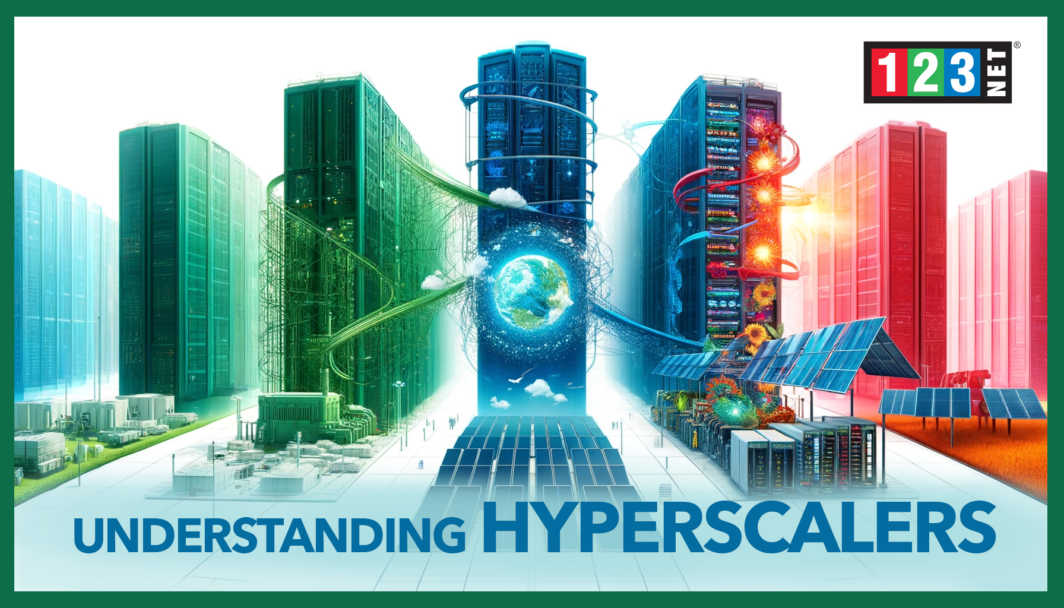
Introduction
Hyperscalers are the backbone of modern technology. It is consisting of extensive server networks and data centers that dynamically scale to meet growing computational demands. This introduction defines hyperscalers and underscores their significance in today’s digital world. We will examine their role in processing vast data volumes, supporting reliable cloud services, and providing scalable solutions. The article delves into the evolution, key attributes, leading providers, applications, challenges, and future directions of hyperscaler technology. It is offering a comprehensive overview of their critical role in advancing technological infrastructures.
The Evolution of Hyperscalers
The concept of hyperscalers has undergone significant evolution since the early days of large-scale data centers. Originally conceived to address the burgeoning needs of big data and expanding internet connectivity. As well as hyperscalers have rapidly advanced to become cornerstones of modern network architecture and computational resource management. Their development was catalyzed by the explosive growth in digital data and the need for highly reliable and scalable infrastructure solutions.
Among the key advancements in hyperscaler technology, the adoption of virtualization technologies stands out. This innovation allows for the efficient management and allocation of resources. It is enabling multiple virtual servers to operate on a single physical server, thereby increasing utilization rates and reducing costs. Another critical development has been the focus on constructing energy-efficient server farms. These are designed to minimize the environmental impact and operational costs associated with large-scale data processing facilities.
This section will explore the historical context and significant milestones in the evolution of hyperscaler technology. We will examine how these technologies have reshaped the landscape of data centers. It is emphasizing their pivotal role in enhancing network architecture and boosting the efficiency of computational resources. This narrative will highlight the technological strides that have solidified hyperscalers as indispensable elements of the global digital infrastructure.
Key Features of Hyperscalers
Hyperscalers are distinguished by several unique features that make them a critical infrastructure choice for handling large-scale computational demands across various industries. Here, we explore the key characteristics that set hyperscalers apart, highlighting their role in enhancing cloud computing infrastructures.
Scalability and Flexibility
One of the foremost attributes of hyperscalers is their ability to scale resources dynamically. This scalability ensures that as the demand for computing power increases or decreases, hyperscalers can adjust their resource allocation seamlessly. This flexibility is vital for businesses experiencing fluctuating workloads, allowing them to maintain efficient operations without overcommitting resources. It not only optimizes cost but also improves the responsiveness of services to end-users.
Energy Efficiency and Sustainability
Hyperscalers leverage cutting-edge technologies to optimize energy use, which is crucial given the extensive power requirements of large data centers. Innovations such as advanced cooling systems, energy-efficient server designs, and the use of renewable energy sources help minimize the environmental impact. These practices are not just about reducing operational costs; they also align with global efforts toward sustainability, making hyperscalers a preferable option for environmentally conscious organizations.
Security Features
Security is a paramount concern for hyperscalers, as they manage and store vast amounts of sensitive data across multiple sectors. To protect this data, hyperscalers implement robust security measures including data encryption, firewalls, intrusion detection systems, and multi-factor authentication. These security protocols ensure that data remains secure from unauthorized access, breaches, and other cyber threats, which is crucial for maintaining trust and reliability in cloud services.
Each of these features plays a crucial role in maintaining the operational integrity and responsiveness of hyperscalers. By ensuring scalable and flexible service delivery, promoting energy efficiency and sustainability, and upholding stringent security standards, hyperscalers continue to serve as foundational components of modern cloud computing infrastructures. Their comprehensive capabilities make them indispensable in today’s digital landscape, supporting everything from everyday business operations to advanced computational tasks like machine learning and big data analytics.
Applications of Hyperscalers
Hyperscalers play a crucial role in enabling a variety of sophisticated applications across different technological domains. Their robust infrastructure supports essential services and operations in cloud computing, big data analytics, and artificial intelligence. This section outlines how hyperscalers facilitate these key applications, emphasizing their versatility and fundamental importance.
Cloud Computing
Hyperscalers provide the robust infrastructure required for cloud computing services, including Software as a Service (SaaS), Platform as a Service (PaaS), and Infrastructure as a Service (IaaS). By offering these services, hyperscalers allow businesses to outsource significant portions of their IT infrastructure, software, and platform needs. This not only reduces the overhead and capital expenditures for companies but also enhances flexibility and scalability. Users can access a range of applications and services via the internet without the need to maintain physical hardware, manage software updates, or handle system integrations.
Big Data Analytics
The ability to process and analyze large volumes of data is crucial for businesses aiming to leverage data-driven strategies. Hyperscalers provide the computational resources necessary to handle big data analytics effectively. They enable the processing of vast datasets quickly and efficiently, allowing for real-time analytics and insights. This capability supports industries like finance, healthcare, and retail, where making informed decisions based on large data sets can significantly impact operational efficiency and strategic planning.
Machine Learning and Artificial Intelligence
Hyperscalers also support complex operations in machine learning and artificial intelligence (AI). They offer the computational power and extensive data storage solutions required for training sophisticated AI models. This support is essential for running deep learning algorithms and other AI processes that require substantial computational resources. By facilitating these technologies, hyperscalers empower innovations in various fields such as autonomous driving, predictive analytics, and personalized customer experiences.
Challenges and Solutions in Hyperscaling
Hyperscalers, despite their significant advantages and capabilities, encounter a variety of challenges that can impact their efficiency and reliability. These challenges range from technical issues such as load balancing and data integrity to operational hurdles associated with managing large-scale infrastructures. This section details these challenges and highlights the innovative solutions being implemented to address them effectively.
Technical Challenges
One of the primary technical challenges faced by hyperscalers is load balancing. Ensuring that the computational load is evenly distributed across servers is crucial for maintaining system performance and preventing any single machine from becoming a bottleneck. Additionally, maintaining data integrity in such vast and complex environments is critical, especially as data volumes grow and more applications become dependent on real-time data analysis. Data corruption or loss can have severe repercussions, affecting customer trust and business operations.
To overcome these technical hurdles, hyperscalers employ advanced algorithms and sophisticated software solutions. Load balancing is managing through automate processes that can dynamically adjust resources based on real-time demands. For data integrity, cutting-edge fault tolerance and redundancy techniques are utilized, such as regular backups, data replication across different geographical locations, and employing distributed databases that ensure consistency and high availability.
Operational Challenges
Operational challenges in hyperscaling involve managing the sheer scale of the infrastructure, which can be daunting and complex. The logistics of deploying, maintaining, and upgrading vast arrays of servers and other hardware, while ensuring minimal downtime, requires meticulous planning and coordination.
To address these challenges, hyperscalers are increasingly turning to automation and AI-driven technologies. Automated management systems are used to streamline operations, from hardware installation and maintenance to software updates and security patches. Furthermore, predictive analytics and machine learning algorithms help in anticipating failures or bottlenecks before they occur, allowing preemptive action to ensure continuous service availability.
Through these innovative solutions, hyperscalers manage to maintain high levels of efficiency and reliability, despite the formidable challenges they face. These strategies not only help in mitigating the risks associated with large-scale operations but also enhance the overall performance and sustainability of hyperscaler infrastructures.

Future Trends in Hyperscaler Technology
The future of hyperscaler technology promises significant advancements driven by emerging trends and innovations. These developments are set to enhance operational efficiencies and sustainability, reflecting the growing importance of advance technologies in shaping the hyperscaler landscape. This section explores the key trends expected to influence hyperscalers in the coming years, highlighting the pivotal role of continuous innovation in their evolution.
Increased Role of AI and Machine Learning
Artificial Intelligence (AI) and machine learning are poise to play an increasingly crucial role in hyperscaler operations. These technologies are integral in optimizing data center efficiency through improved automation and predictive analytics. AI algorithms can predict hardware failures, optimize power usage, and automate routine tasks, thereby enhancing system reliability and reducing manual interventions. Machine learning models also contribute to improving load balancing and resource allocation, ensuring that hyperscaler infrastructures can dynamically adjust to changes in demand without compromising performance.
Innovations in Energy Efficiency
As global focus shifts towards sustainability, hyperscalers are under pressure to minimize their environmental footprint. Innovations aimed at enhancing energy efficiency are crucial in this respect. Advance cooling technologies, more efficient server designs, and the integration of renewable energy sources are among the strategies adopt to reduce power consumption. These technologies not only lower operational costs but also align hyperscaler operations with environmental sustainability goals.
The continual integration of AI and sustainable practices within hyperscaler infrastructures demonstrates a commitment to innovation and efficiency. Looking ahead, these trends are to expect to drive further enhancements in hyperscaler technology, ensuring they remain at the forefront of digital infrastructure development while promoting ecological responsibility.




